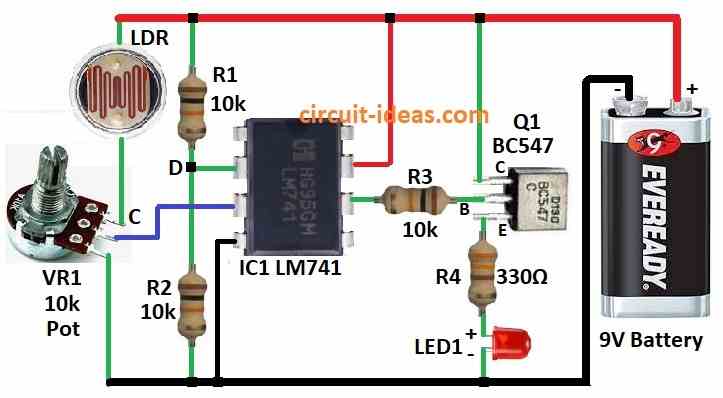LDR change resistance when light fall on it.
This is used in Light Detector Circuit using Wheatstone Bridge.
One side of bridge has LDR and one fixed resistor in series.
Other side has potentiometer and second fixed resistor in series.
Voltage is given to two opposite corners of bridge.
The output voltage taken from other two corners.
Op-amp can make small output voltage bigger.
This bigger voltage can turn ON the LED.
When light hits the LDR the output voltage goes down and LED turns ON.
Circuit Working:

Parts List:
| Category | Item | Quantity |
|---|---|---|
| Resistors | 10k 1/4 watt | 3 |
| 330Ω 1/4 watt | 1 | |
| Potentiometer 10k | 1 | |
| LDR | LDR | 1 |
| Semiconductors | IC LM741 | 1 |
| Transistor BC547 | 1 | |
| LED red 5mm 20mA | 1 | |
| 9V Battery | 1 |
Our light detector circuit work like balance scale but is used in light as weight.
Scale has two sides.
One side has LDR the light sensor and adjustable resistor the potentiometer.
Other side has two same fixed resistors with 10k ohms.
In dark LDR act like heavy weight means in high resistance and tilt the scale.
When light come LDR get lighter with low resistance and balances the scale.
Special chip called op-amp act like referee and it watches voltage at point C and point D.
In dark LDR side which is point C has more voltage and op-amp sees the imbalance.
When light hits the LDR, both sides C and D have similar voltage and the scale is balanced.
Op-amp uses this information to control small switch like transistor.
If dark voltage is high on LDR side and op-amp turns ON the switch and LED turns ON.
If bright voltages is equal and op-amp turns OFF the switch and LED turns OFF.
In simple words the LED turns ON in dark and turns OFF in light.
It work by LDR reacting to light.
What is Wheatstone Bridge and its formula:
Wheatstone bridge is circuit to measure unknown resistance.
It has two legs means sides one leg has unknown resistor.
When both legs are balanced with no current flow in middle and we can find unknown resistor.
It gives more accurate result than normal voltage divider.
It work like old-style potentiometer.

Formula:
It is important to understand balance in Wheatstone bridge same voltage at point C and D.
Balance happen when:
R1 / R2 = R3 / R4
This means ratio of R1 to R2 is same as R3 to R4.
When bridge is balanced then voltage at C and D is equal so no current flow between them.
How to Build:
To build a Light Detector Circuit using Wheatstone Bridge below mentioned are the steps for connections:
- Put all parts like shown in circuit diagram.
- Connect pin 2 of IC1 LM741 op-amp to middle of R1 and R2.
- Connect pin 3 of IC1 to center pin of VR1 potentiometer.
- Connect pin 4 of IC1 to ground.
- Connect pin 6 of IC1 to base of transistor Q1.
- Connect pin 7 of IC1 to +9V battery.
- Connect top leg of VR1 to +9V through LDR.
- Connect center leg of VR1 to pin 3 of IC1.
- Connect bottom leg of VR1 to ground.
- Q1 collector goes to +9V.
- Base goes to pin 6 of IC1 through resistor R3.
- Emitter goes to ground through resistor R4 and LED1.
Safety Tips:
- Op-amps are sensitive to static and touch metal to ground, before touching them.
- Op-amps can get hot so if needed use heat sink to cool.
- Always double check the wiring as wrong connection can damage the parts.
- Follow diagram and connect carefully.
- Be safe while making and testing circuit.
Conclusion:
Light Detector Circuit works like balance scale using Wheatstone bridge.
In dark LDR acts like heavy weight and tilts balance and turns ON the LED.
In light the balance is even and LED turns OFF.
Op-amp works like referee and checks balance and controls the LED.
Always put safety first and use correct tools, safe power and work on non-metal surface.
Have fun making our own light detector!
Leave a Reply